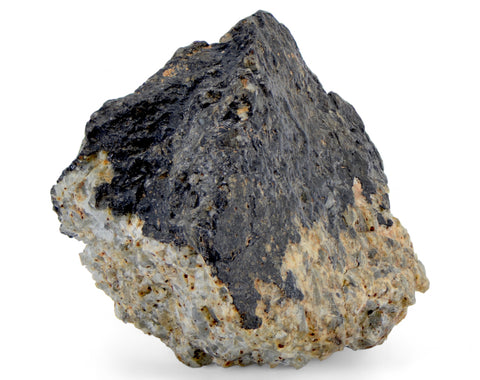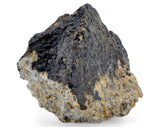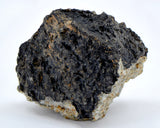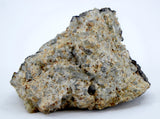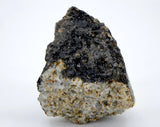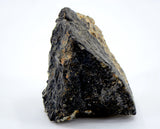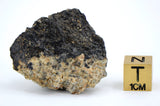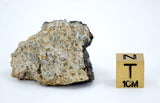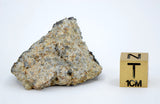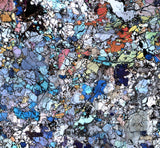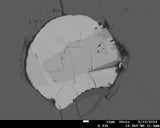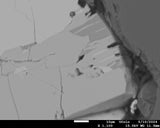23.01g Ungrouped Achondrite Meteorite I NWA 15915
On Offer: 23.01 gram fragment of NWA 15915 achondrite-ung
Official Name: Northwest Africa 15915
Abbreviation: NWA 15915
Classification: Achondrite Ungrouped
Classification Notes: This is an unusual highly reduced ungrouped achondrite that was ejected from an unknown differentiated parent body (asteroid or planet) that is hypothesized to have formed close to the current orbit of the planet Mercury.
Country: Algeria
Year Found: 2023
Description / Information: 23.01g specimen of the rare ungrouped achondrite NWA 15915. This meteorite is a highly reduced magnesian clinopyroxenite. This specimen has a beautiful fresh black fusion crust. In my opinion, this is one of the most interesting new meteorites to be found in quite some time. This meteorite is a clinopyroxenite with a composition of approximately 90% magnesian end-member augite (subcalcic diopside), with the remainder being composed of equally reduced magnesian end-member orthopyroxene and aubrite like exotic sulfides.
Our laboratory has done EPMA (microprobe) and Raman (spectrographic) analysis on NWA 15915 and its pairing Ksar Ghilane 022 / 023 (see below for my screenshot of my abstract and information on the pairing). This meteorite is one of the most reduced (formed in low oxygen environment) ungrouped achondrite meteorites ever discovered.
NWA 15915 contains immiscible spherules of exotic cubic sulfides. These sulfides are composed of a single Sulfur anion ionically bound to a metal cation such as Ca, Mg, Mn, or Cr that, under normal circumstances, would be siderophile (iron loving). However, under the highly reducing conditions of the parent body, became calcophile (sulfur loving). It was this unique set of conditions that allowed for the formation these exotic cubic sulfides. Some of these exotic cubic sulfides, such as oldhamite, require extremely high temperatures and a reduced environment (low oxygen) to form.
The presence of these exotic sulfides lead some researchers, including myself, to hypothesize that they likely formed on a parent body (large asteroid or planet) that formed very close to the sun (near the orbit of Mercury). There is some possibility the parent body of this meteorite may have been Mercury itself. This conclusion cannot be verified. We have no ground truth (return samples) from Mercury to compare with these meteorites. However, the hypothesis that NWA 15915 and KG 022/023 were formed on a parent body (large asteroid or planet) that itself formed near the orbit of Mercury is supported by its highly reduced geochemistry and the presence of oldhamite and other exotic aubrite-like cubic sulfides.
After my own extensive EPMA and Raman analysis, as well as additional isotopic analysis with better sampling done at Open University in the UK, I am satisfied that NWA 15915 and KG 022/023 are paired and from the same parent body and likely the same ejection event. Some researchers contend that this meteorite does not pair with Ksar Ghilane 022 / 023 due to a difference in their texture (crystal size), amount of sulfides present (more sulfides in NWA 15915), and because they were reportedly found in different areas of the same region.
My research shows them to have nearly identical geochemistry, mineralogy, and only a slightly different petrology (texture). This difference in texture and (slight difference in sulfide mode) can be easily explained by formation in the same source magma chamber but at different depths. NWA 15915 cooling slower at greater depth resulting in larger crystals / grains and with KG 022/023 forming at shallower depth and cooling faster resulting in smaller crystals / grains. The sulfides in these two meteorites are present as immiscible spherules that while still liquid would have been heavier than the parent liquid (magma) and thus had a negative buoyancy and would have had a tendency to sink to lower depths thus enriching the NWA 15915 part of the parent magma. I hope to further support this hypothesis in an upcoming publication.
 Above: Raman color enhanced micrograph taken of a petrographic thin section of NWA 15915.
Above: Raman color enhanced micrograph taken of a petrographic thin section of NWA 15915. 
Above: Complex polyphase sulfide spherule in NWA 15915 BSE image



Above: Abstract on NWA 15915 for 2024 Meteoritical Society meeting in Brussels.
| Northwest Africa 15915 | |||||||||||||||||||||||||||||
|---|---|---|---|---|---|---|---|---|---|---|---|---|---|---|---|---|---|---|---|---|---|---|---|---|---|---|---|---|---|
| Basic information |
Name: Northwest Africa 15915 This is an OFFICIAL meteorite name. Abbreviation: NWA 15915 Observed fall: No Year found: 2023 Country: Algeria Mass: 2.84 kg |
||||||||||||||||||||||||||||
| Classification history: |
This is 1 of 172 approved meteorites classified as Achondrite-ung. |
||||||||||||||||||||||||||||
| Comments: | Approved 30 Jul 2023 | ||||||||||||||||||||||||||||
| Writeup |
Writeup from MB 112:
Northwest Africa 15915 (NWA 15915) Algeria Purchased: 2023 Feb Classification: Ungrouped achondrite History: Purportedly found near Aougrout, Algeria. The largest stone was purchased from the finder by Jaouad Chaoui in October 2022, and subsequently cut and sold in two portions to Jay Piatek and Ben Hoefnagels in February 2023. Physical characteristics: The pale yellowish stones (1359, 808, 650, and 26 g) are partially coated with black fusion crust. The very fresh interiors are predominantly beige in color and somewhat friable. Petrography: (A. Irving, UWS, and J. Boesenberg, BrownU) Coarse grained protogranular aggregate (mean grainsize ~2 mm) composed predominantly of homogeneous, almost pure end-member augite (with sparse, very thin exsolution lamellae of enstatite) accompanied by subordinate discrete grains of enstatite (~ 10 vol.%) and accessory daubreelite, alabandite, troilite, minor low-Ni kamacite and secondary Fe oxide. Olivine and plagioclase are absent. Geochemistry: Augite (Fs0.0-0.1Wo37.5-43.3, FeO = 0.02-0.08 wt.%, N = 16), enstatite (Fs0.1-0.3Wo0.5-3.2, N = 9). Oxygen isotopes (D. Ibarra, BrownU): analysis of an acid-washed subsample by laser fluorination gave, respectively δ17O 3.369, δ18O 6.470, Δ17O -0.035 per mil (TFL slope value = 0.526). Classification: Achondrite (ungrouped, Mg-rich clinopyroxenite). These specimens bear some petrologic and isotopic resemblance to Mg-rich websteritic achondrite NWA 13307, but differ in being much richer in clinopyroxene. Although the Δ17O values for both of these Mg-rich specimens are identical, the δ18O value for this specimen is higher by 1 per mil. relative to NWA 13307. Specimens: 23.8 g including one polished thin section at UWB; portions of the 1359 g main mass are held separately by Mr. J. Piatek (645 g) and Mr. B. Hoefnagels (650 g); other stones of 808 g, 650 g and 26 g are held by Mr. M. Lyon. |
||||||||||||||||||||||||||||
| Data from: MB112 Table 0 Line 0: |
|
||||||||||||||||||||||||||||
| Plots: | O isotopes: |
||||||||||||||||||||||||||||
We Also Recommend

